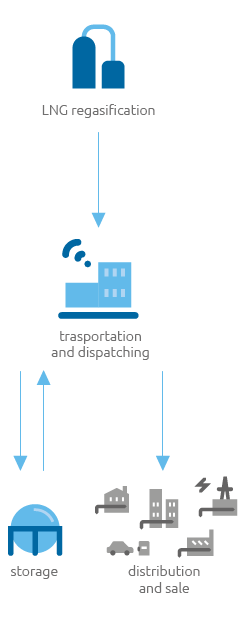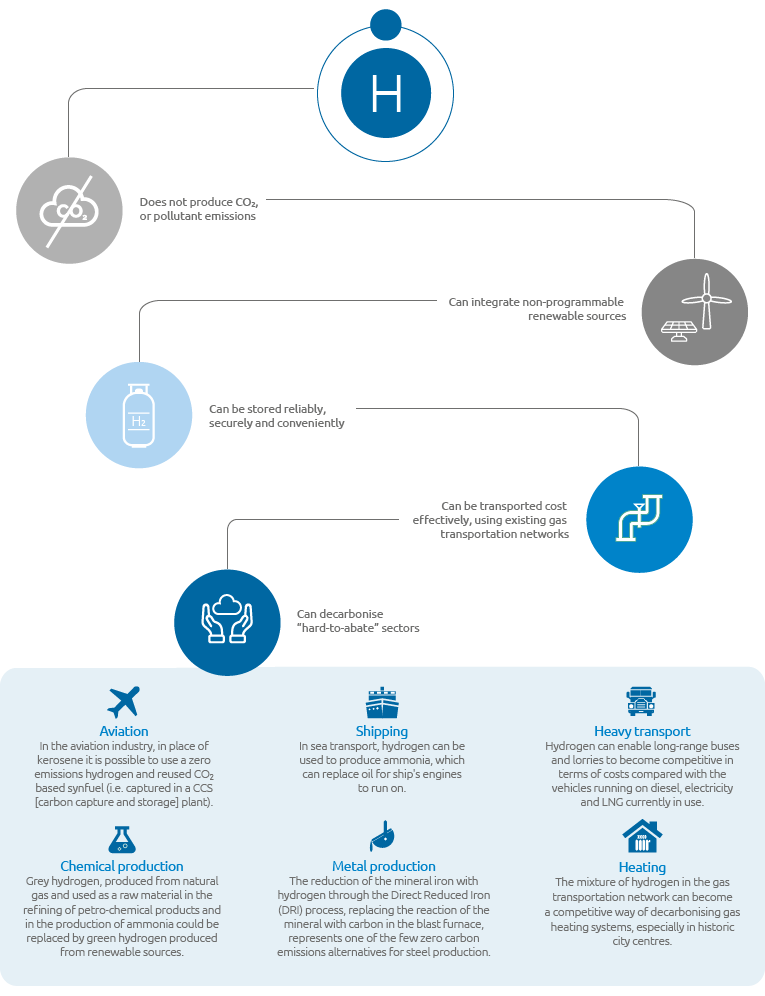Summary
Snam is the leading operator in Italy and Europe in the creation and integrated management of natural gas infrastructure.
With around 3,000 employees and over 32,600 km of network, in Italy Snam oversees the natural gas transportation, dispatching and storage activities, as well as the regasification of liquefied natural gas (LNG). Alongside its core business, the company is also investing to an increasing extent in new businesses related to energy transition, from sustainable mobility to energy efficiency and the development of renewable gases such as biomethane and hydrogen.
Snam operates in Europe’s major markets through agreements with the leading industry players and direct equity investments in the share capital of various companies. The company also offers engineering and technical-operational services for gas operators in national and international markets.
Snam: integrated network to
drive the energy sector evolution

Snam actively promotes the use of natural gas as a flexible energy source with a low environmental impact in classical industrial and residential sectors as well as in the transport sector. According to the company’s vision, natural gas, which in recent years has recorded a recovery in demand thanks to various countries gradually phasing out coal-produced thermoelectricity, will be a pillar on energy systems in the long-term, also thanks to the potential development of biomethane and hydrogen, especially in sectors in which the electrification process is difficult to achieve.
Snam’s, capital intensive, business, mainly focuses on regulated activities. Regulation makes provision for tariff systems that cover the costs incurred by the operator and for a fair return on invested capital. Snam is therefore able to maintain a limited risk profile and provide its shareholders with attractive and sustainable returns, at the same time ensuring the provision of services to all operators in a non-discriminatory manner and with the highest standards of quality and safety.
In line with its own sustainable development model, and alongside carrying out its own core business, in recent years Snam has launched numerous projects aimed at promoting a more sustainable energy system, developing initiatives and interventions under the scope of energy efficiency, for compressed natural gas (CNG), liquefied natural gas (LNG) and biomethane and in 2019 creating a new business unit dedicated to hydrogen, with the objective of evaluating potential pilot projects and contributing to the development of the supply chain. In 2019, for the first time in Europe, Snam trialled the introduction into the transmission network of a mixture of natural gas and hydrogen, first 5% and then 10% in volume.
The company has been listed on the Italian stock exchange since 2001. Snam stock is traded, not only on the Italian FTSE Mib, but also on the main international indices (Stoxx Europe 600 and Stoxx Europe 600 Utilities) and numerous sustainability indices, including the most prestigious, such as the Dow Jones Sustainability World Index and the FTSE4Good, as well as being at the top of the MSCI ESG ratings (MSCI World ESG and MSCI ACWI ESG), Sustainalytics, ECPI, Ethibel, Vigeo and Snam is included in the 2020 Bloomberg Gender-Equality Index (GEI).
In addition, Snam has been confirmed among the globally-recognised companies for their commitment to combating climate change. In 2019 the company was confirmed on the “Climate Change A-List” of the CDP (formerly the Carbon Disclosure Project), demonstrating the effectiveness of the ongoing efforts to reduce emissions and climate risks.
To reinforce the commitment to initiatives aimed at combating climate change, an important innovation was the issuing, in February 2019, of the first Climate Action Bond in Europe (and the second globally), a financial instrument used to allocate funds to projects for reducing CO² emissions, the development of renewables, energy efficiency and the development of green projects based on environmental criteria. In addition, in April 2019 the Company reduced the margin of its sustainable loan from €3.2 billion, after reaching the targets related to social and environmental sustainability parameters.
In the current context of energy transition and Snam’s increasing central role in achieving national and European commitments, at the end of November 2019 the company launched the new Strategic Plan for the period 2019-2023, tracing the route which in the years to come will make it possible to generate sustainable growth and value for its stakeholders, as well as taking on the challenges associated with climate change.
The targets set in the new plan, all more challenging than those in the previous plan, focus on the continued creation of value for regulated activities and take on a leading role in energy transition through the use of natural gas and biomethane and the increasing exposure to new businesses such as sustainability mobility, energy efficiency and, in the long-term, hydrogen as the clean energy source of the future. Snam’s commitment to decarbonisation is confirmed by the continuous increase in the investments it makes in innovation and the acceleration of new green businesses under the scope of the SnamTec project: more than 20% (€1.4 billion) of the €6.5 billion of investments is allocated to this project, €400 million of which is dedicated to new businesses for energy transition, double the figure of €200 million in the previous plan and directed at expanding corporate know-how with regard to technologies related to decarbonisation.
The business of transporting and storing natural gas allows the development of multiple projects linked to the promotion of compressed natural gas (CNG) for motor transport and liquefied natural gas (LNG) used in heavy land and maritime transport. In this context, in future years, Snam will be committed to upgrading the existing infrastructure in order to expand the network of refilling stations.
The Company considers itself as a point of reference for the integration of the Italian energy mix of biomethane and hydrogen, sources of clean, versatile energy, which promote the existing transportation and storage structures and allow an increase in production and consequently the flexibility of national energy procurement.
Main advantages of the green hydrogen and application in the "hard-to-abate" sectors
